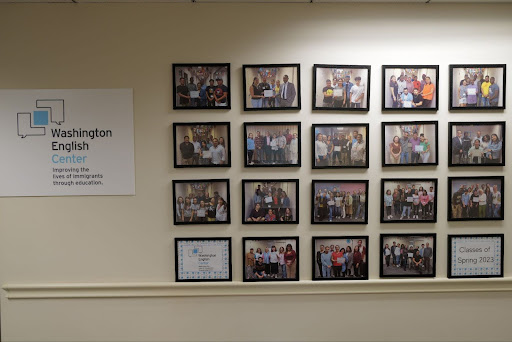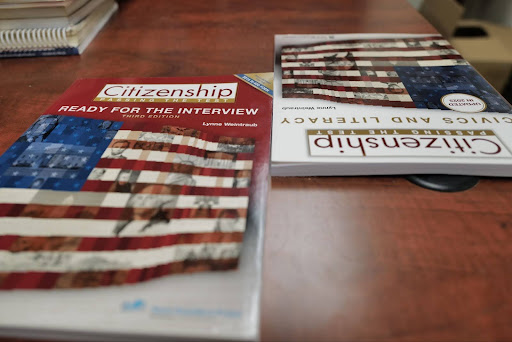WASHINGTON – Every week in downtown D.C., near the National Archives and the Smithsonian American Art Museum, hundreds of aspiring new Americans from 100 different countries navigate past groups of tourists and students on field trips to attend in-depth civics classes.
They come together at the Washington English Center, where phonics posters and flags from around the world transform the lower level of an office building into a language and citizenship school. Students are taught varying levels of English and prepare for the culmination of the naturalization process – the citizenship test.
Nationwide, 9 million immigrants are eligible for U.S. citizenship, yet 91 percent do not proceed with their applications, according to a survey conducted by the nonprofit loan service One Percent for America. Organizations like the Washington English Center offer support to make the naturalization process more accessible.
One of the main reasons people cite for not going through the citizenship process is the price. One Percent for America found that 14 percent of the applicants think the application fee is the greatest challenge to becoming a citizen, and 67 percent of them used high-interest loans to cover the cost.
Immigrants have to pay for the naturalization application, usually $725 per person, before taking the test and submitting all the immigration documents, according to the U.S. Citizenship and Immigration Services. And starting April 1, that price is going up.
The price will rise to $760 if applicants file by paper. Would-be citizens can pay less if they apply online or seek exceptions based on low income. The price increase is part of a standard review process and is the first significant jump in seven years.
The price will rise to $760 if applicants file by paper. Would-be citizens can pay less if they apply online or seek exceptions based on low income. The price increase is part of a standard review process and is the first significant jump in seven years.
Beyond financial burdens, the citizenship test itself presents a daunting challenge. The test requires a high level of English proficiency and civics knowledge in order to complete the reading, writing and speaking sections.
Citizenship and Immigration Services reported an 88 percent first-time pass rate with 95.7 percent of test takers succeeding on a second try. In comparison, a 2018 survey from the Institute for Citizens and Scholars found that only 36 percent of Americans would pass the civics test.
Eduardo Corrêa was shocked by the high price of English classes near his home in Montgomery County, Md., where many schools charge hundreds of dollars. Washington English Center, which offers a 10-week citizenship course for $50, was a welcome alternative for him and his wife.
“Let’s go for it,” Corrêa said he told her.
He and his wife, who is a U.S. citizen but grew up in Brazil, are physicists who immigrated for better work opportunities. Corrêa’s desire to be a researcher for the government was a driving factor in his pursuit of citizenship.
Adrian Popescu, a current student at the Washington English Center, knew that people immigrate to the U.S. for a variety of reasons, but for him, it was true love. Popescu met his American diplomat wife six years ago in his home country, Moldova. They quickly got married, then Popescu followed her to the United States.
“I have never believed I will arrive [in this country],” Popescu said. “I didn’t choose this country. I think the country chose me. It was just pure fate.”
To help in his preparation for the test, Popescu is taking a citizenship class at the Washington English Center. He said the class has also enriched his understanding of American history and traditions.
“I don’t know how to describe how good the class is and how much it helps me to understand the United States of America,” Popescu said.

The Washington English Center displays photos of students and teachers. (Yiqing Wang/Medill News Service)
About 700 students take classes at the center at one time. Their teachers are all volunteers. For Chris Paulus, teaching is a meaningful way to spend his free time after he retired from the Department of the Navy.
“Students are very motivated,” said Paulus. “They have just various questions about it going deeper into some of the history of the United States.”
Another volunteer, Jenise Dorf, enjoys incorporating current events, such as the Super Tuesday presidential primaries, into her lessons. Dorf has found teaching citizenship classes to be “very rewarding.”
“I so admire these people, because they have come over here from a different country. They are bilingual, at the very least, they are trying to have a life in a new country,” Dorf said. “It’s mind-boggling to me, and I just so respect these people. I so admire them, and I love, I love, love, love how engaged they get in the subject matter.”
Immigrants are growing as a percentage of D.C.’s population. In 2022, 15 percent of city residents were immigrants, up 36 percent from 2000, according to the Migration Policy Institute.
Jessie Ebersole, director of programs at the Washington English Center, has found that the area’s cultural diversity is evident in the makeup of the organization’s students.
“We have, at any given time, around 100 countries represented in our student body,” Ebersole said. “But it really is a place where people meet people from all over, and then also get exposed to teachers from all over because we have this volunteer teaching model.”
The center also partners with other organizations to connect immigrants with reduced-fee legal services.
Those who need financial support with the citizenship process can turn to One Percent For America, which provides 1 percent interest loans for naturalization and other immigration application fees.
“Immigrants contribute a lot to the U.S. economy,” said Deeba Zavari, senior manager of strategic partnerships at One Percent for America. “What’s interesting is that there’s a gap between all this contribution they’re making while they don’t have the same access to the financial tools that citizens have.”
The American Immigration Council, a research group, found that immigrants paid over $500 billion in taxes in 2021 and held $1.4 trillion in spending power.
Connecting immigrants with groups offering help can be a challenge. Paulus suggested that Citizenship and Immigration Services should provide more resources to help applicants prepare not only for the test but also for their upcoming new life, such as offering different translations of mock tests or connecting applicants with legal services.
“I think the resources are there, the groups are there to help. But how did these immigrants who have maybe limited English get to those resources?” Paulus said.
Houston Endowment, another nonprofit, works to bolster arts, parks, public education and civic engagement. Its mission includes encouraging naturalization.
“We have just a really large number of people in Greater Houston who are eligible but have not taken this step [towards citizenship],” said Gislaine Williams, program officer for civic engagement at Houston Endowment. Williams and other workers are looking for a better approach to address the barriers and increase their ability to access naturalization services.
Some immigrants also expressed hesitancy to pursue citizenship because they did not want to formally separate from their home country, according to Williams, who wants to educate the community about the dual citizenship option.
The November elections could foreshadow more changes in the citizenship process if former President Donald Trump were to win.
In 2019, then-President Trump tried but failed to increase the naturalization fee by $500, as well as implement a fee for asylum seekers and end a program that provides reduced fees to low-income applicants.
Beyond the naturalization fee, the price of a green card, status adjustment and several other applications will increase on April 1. The increases are each below 26 percent and availability of fee waivers has also been expanded so more households can qualify, according to Citizenship and Immigration Services.
Even as debate over illegal border crossings dominates the conversation, a growing number of immigrants from across the globe are doing what it takes to become citizens. Rates of naturalization have recovered since the Covid-19 pandemic with 2022 and 2023 making up 24 percent of naturalizations in the past decade.
Corrêa, the Washington English Center student from Brazil, passed his citizenship test in February and was waiting to officially become an American. After hearing his results, he knew just who to share the news with.
“At the end of the interview, they give you the document saying that, ‘Okay, we recommend your citizenship to USCIS,’” Corrêa said. “And as soon as I got the letter I wrote to these teachers I had there and they were really happy and excited that I was approved. It’s nice having this kind of interaction with them.”


